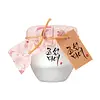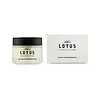What's inside
What's inside
 Key Ingredients
Key Ingredients

 Benefits
Benefits

 Concerns
Concerns

 Ingredients Side-by-side
Ingredients Side-by-side

Water
Skin ConditioningGlycerin
HumectantButylene Glycol
HumectantNiacinamide
SmoothingDipentaerythrityl Hexa C5-9 Acid Esters
Skin ConditioningSodium Hyaluronate
HumectantXanthan Gum
EmulsifyingCyclopentasiloxane
EmollientCyclohexasiloxane
EmollientPolyacrylate-13
Polyisobutene
Polysorbate 20
EmulsifyingHydrogenated Lecithin
EmulsifyingC14-28 Alkyl Acid
Stearyl Alcohol
EmollientBehenyl Alcohol
EmollientDimethicone/Vinyl Dimethicone Crosspolymer
Skin ConditioningDimethicone
EmollientAdenosine
Skin ConditioningGlyceryl Stearate Se
EmulsifyingCetearyl Alcohol
EmollientPolyglyceryl-3 Methylglucose Distearate
EmulsifyingCetyl PEG/PPG-10/1 Dimethicone
EmulsifyingStearic Acid
CleansingTocopheryl Acetate
AntioxidantSodium Polyacrylate
AbsorbentOlea Europaea Fruit Oil
MaskingHelianthus Annuus Seed Oil
EmollientCentella Asiatica Extract
CleansingHippophae Rhamnoides Oil
EmollientArgania Spinosa Kernel Oil
EmollientButyrospermum Parkii Butter
Skin ConditioningCeramide NP
Skin ConditioningTrehalose
HumectantCalendula Officinalis Flower Extract
MaskingCaprylhydroxamic Acid
1,2-Hexanediol
Skin ConditioningRaphanus Sativus Leaf Extract
HumectantOryza Sativa Bran Extract
Skin ConditioningCucurbitaceae Extract
Skin ConditioningOrchid Extract
Skin ConditioningHoney Extract
HumectantPanax Ginseng Root Extract
EmollientCarthamus Tinctorius Seed Oil
MaskingPhytosphingosine
Skin ConditioningCeteareth-20
CleansingGlyceryl Citrate/Lactate/Linoleate/Oleate
EmulsifyingParfum
MaskingWater, Glycerin, Butylene Glycol, Niacinamide, Dipentaerythrityl Hexa C5-9 Acid Esters, Sodium Hyaluronate, Xanthan Gum, Cyclopentasiloxane, Cyclohexasiloxane, Polyacrylate-13, Polyisobutene, Polysorbate 20, Hydrogenated Lecithin, C14-28 Alkyl Acid, Stearyl Alcohol, Behenyl Alcohol, Dimethicone/Vinyl Dimethicone Crosspolymer, Dimethicone, Adenosine, Glyceryl Stearate Se, Cetearyl Alcohol, Polyglyceryl-3 Methylglucose Distearate, Cetyl PEG/PPG-10/1 Dimethicone, Stearic Acid, Tocopheryl Acetate, Sodium Polyacrylate, Olea Europaea Fruit Oil, Helianthus Annuus Seed Oil, Centella Asiatica Extract, Hippophae Rhamnoides Oil, Argania Spinosa Kernel Oil, Butyrospermum Parkii Butter, Ceramide NP, Trehalose, Calendula Officinalis Flower Extract, Caprylhydroxamic Acid, 1,2-Hexanediol, Raphanus Sativus Leaf Extract, Oryza Sativa Bran Extract, Cucurbitaceae Extract, Orchid Extract, Honey Extract, Panax Ginseng Root Extract, Carthamus Tinctorius Seed Oil, Phytosphingosine, Ceteareth-20, Glyceryl Citrate/Lactate/Linoleate/Oleate, Parfum
Water
Skin ConditioningNelumbo Nucifera Leaf Extract
Skin ConditioningGlycerin
HumectantDipropylene Glycol
HumectantCetyl Ethylhexanoate
EmollientCaprylic/Capric Triglyceride
MaskingGlyceryl Stearate
EmollientCetearyl Alcohol
EmollientPentaerythrityl Tetraethylhexanoate
Emollient1,2-Hexanediol
Skin ConditioningBetaine
HumectantDimethicone
EmollientQuercus Acuta Branch/Leaf Extract
Skin ConditioningCyclopentasiloxane
EmollientBeeswax
Emulsion StabilisingSorbitan Stearate
EmulsifyingPEG-100 Stearate
Butylene Glycol
HumectantPolyacrylamide
Palmitic Acid
EmollientEthylhexylglycerin
Skin ConditioningCaprylyl Glycol
EmollientPolysilicone-11
Stearic Acid
CleansingC13-14 Isoparaffin
EmollientCarbomer
Emulsion StabilisingTromethamine
BufferingNylon-12
Silica
AbrasiveHippophae Rhamnoides Oil
EmollientAdenosine
Skin ConditioningLavandula Angustifolia Oil
MaskingCitrus Limon Peel Oil
MaskingLaureth-7
EmulsifyingDisodium EDTA
Ammonium Polyacryloyldimethyl Taurate
Emulsion StabilisingIsohexadecane
EmollientPolysorbate 40
EmulsifyingPEG-10 Dimethicone
Skin ConditioningCitrus Aurantifolia Oil
CleansingEucalyptus Globulus Leaf Oil
PerfumingRosmarinus Officinalis Leaf Oil
MaskingLauric Acid
CleansingMyristic Acid
CleansingCaramel
Cosmetic ColorantJuniperus Mexicana Oil
MaskingChamomilla Recutita Flower Oil
MaskingDextrin
AbsorbentPelargonium Graveolens Flower Oil
MaskingWater, Nelumbo Nucifera Leaf Extract, Glycerin, Dipropylene Glycol, Cetyl Ethylhexanoate, Caprylic/Capric Triglyceride, Glyceryl Stearate, Cetearyl Alcohol, Pentaerythrityl Tetraethylhexanoate, 1,2-Hexanediol, Betaine, Dimethicone, Quercus Acuta Branch/Leaf Extract, Cyclopentasiloxane, Beeswax, Sorbitan Stearate, PEG-100 Stearate, Butylene Glycol, Polyacrylamide, Palmitic Acid, Ethylhexylglycerin, Caprylyl Glycol, Polysilicone-11, Stearic Acid, C13-14 Isoparaffin, Carbomer, Tromethamine, Nylon-12, Silica, Hippophae Rhamnoides Oil, Adenosine, Lavandula Angustifolia Oil, Citrus Limon Peel Oil, Laureth-7, Disodium EDTA, Ammonium Polyacryloyldimethyl Taurate, Isohexadecane, Polysorbate 40, PEG-10 Dimethicone, Citrus Aurantifolia Oil, Eucalyptus Globulus Leaf Oil, Rosmarinus Officinalis Leaf Oil, Lauric Acid, Myristic Acid, Caramel, Juniperus Mexicana Oil, Chamomilla Recutita Flower Oil, Dextrin, Pelargonium Graveolens Flower Oil
Alternatives
Ingredients Explained
These ingredients are found in both products.
Ingredients higher up in an ingredient list are typically present in a larger amount.
1,2-Hexanediol is a synthetic liquid and another multi-functional powerhouse.
It is a:
- Humectant, drawing moisture into the skin
- Emollient, helping to soften skin
- Solvent, dispersing and stabilizing formulas
- Preservative booster, enhancing the antimicrobial activity of other preservatives
Adenosine is in every living organism. It is one of four components in nucleic acids that helps store our DNA.
Adenosine has many benefits when used. These benefits include hydrating the skin, smoothing skin, and reducing wrinkles. Once applied, adenosine increases collagen production. It also helps with improving firmness and tissue repair.
Studies have found adenosine may also help with wound healing.
In skincare products, Adenosine is usually derived from yeast.
Learn more about AdenosineButylene Glycol (or BG) is used within cosmetic products for a few different reasons:
Overall, Butylene Glycol is a safe and well-rounded ingredient that works well with other ingredients.
Though this ingredient works well with most skin types, some people with sensitive skin may experience a reaction such as allergic rashes, closed comedones, or itchiness.
Learn more about Butylene GlycolCetearyl alcohol is a mixture of two fatty alcohols: cetyl alcohol and stearyl alcohol. It is mainly used as an emulsifier. Emulsifiers help prevent the separation of oils and products. Due to its composition, it can also be used to thicken a product or help create foam.
Cetearyl alcohol is an emollient. Emollients help soothe and hydrate the skin by trapping moisture.
Studies show Cetearyl alcohol is non-toxic and non-irritating. The FDA allows products labeled "alcohol-free" to have fatty alcohols.
This ingredient is usually derived from plant oils such as palm, vegetable, or coconut oils. There is debate on whether this ingredient will cause acne.
Due to the fatty acid base, this ingredient may not be Malassezia folliculitis safe.
Learn more about Cetearyl AlcoholCyclopentasiloxane, or D5, is a silicone used to improve texture of products and trap moisture.
D5 is considered lightweight and volatile. Volatile means it evaporates quickly after application. Once evaporated, D5 leaves a thin barrier that helps keep skin hydrated.
It is also an emollient. Emollients help soften the skin and prevent water loss. Silicones create a silky texture in products. D5 helps other ingredients become more spreadable.
Studies show D5 is safe to use in skincare products. We recommend speaking with a skincare professional if you have concerns.
Learn more about CyclopentasiloxaneDimethicone is a type of synthetic silicone created from natural materials such as quartz.
What it does:
Dimethicone comes in different viscosities:
Depending on the viscosity, dimethicone has different properties.
Ingredients lists don't always show which type is used, so we recommend reaching out to the brand if you have questions about the viscosity.
This ingredient is unlikely to cause irritation because it does not get absorbed into skin. However, people with silicone allergies should be careful about using this ingredient.
Note: Dimethicone may contribute to pilling. This is because it is not oil or water soluble, so pilling may occur when layered with products. When mixed with heavy oils in a formula, the outcome is also quite greasy.
Learn more about DimethiconeGlycerin is already naturally found in your skin. It helps moisturize and protect your skin.
A study from 2016 found glycerin to be more effective as a humectant than AHAs and hyaluronic acid.
As a humectant, it helps the skin stay hydrated by pulling moisture to your skin. The low molecular weight of glycerin allows it to pull moisture into the deeper layers of your skin.
Hydrated skin improves your skin barrier; Your skin barrier helps protect against irritants and bacteria.
Glycerin has also been found to have antimicrobial and antiviral properties. Due to these properties, glycerin is often used in wound and burn treatments.
In cosmetics, glycerin is usually derived from plants such as soybean or palm. However, it can also be sourced from animals, such as tallow or animal fat.
This ingredient is organic, colorless, odorless, and non-toxic.
Glycerin is the name for this ingredient in American English. British English uses Glycerol/Glycerine.
Learn more about GlycerinHippophae Rhamnoides Oil also known as seabuckthorn oil. This oil is usually extracted from the fruit pulp or seeds.
Seabuckthorn is rich in phytosterols, carotenoids, Vitamins A, C, and E. This gives it strong antioxidant properties that can help soothe and protect your skin from oxidative damage.
This oil is rich in fatty acids, including: two types of linoleic acid (~30-34%), oleic acid (17%), and palmiteic acid (35%). Note these numbers are averages, and different parts of the plant will vary.
Palmitoleic acid has been shown to help soothe inflammation and promote wound healing. It is also naturally found in the fat of our skin.
Overall, seabuckthorn oil is great for nourishing, hydrating, and soothing skin. While it shows UV protecting properties, it should not replace sunscreen.
Due to the rich fatty acid content, this ingredient may not be Malassezia folliculitis, or fungal acne, safe.
Seabuckthorn berries are little orange fruits. This plant is native to Asia.
Learn more about Hippophae Rhamnoides OilStearic Acid is a fatty acid. It is an emollient, emulsifier, and texture enhancer.
As an emollient, stearic acid helps soften skin. It aids the skin's protective barrier by preventing water loss. It also provides a gentle cleansing effect without stripping away natural oils.
Stearic acid may also be used to enhance the texture of products. It can add volume and stabilize ingredients such as water and oil. This can help water and oil ingredients from separating.
Sources of stearic acid include animal or vegetable fats/oils such as coconut or shea. It can be naturally found in butter, cocoa butter, shea butter, vegetable fats, and animal tallow.
This ingredient may not be Malassezia folliculitis, or fungal-acne safe.
Learn more about Stearic AcidWater. It's the most common cosmetic ingredient of all. You'll usually see it at the top of ingredient lists, meaning that it makes up the largest part of the product.
So why is it so popular? Water most often acts as a solvent - this means that it helps dissolve other ingredients into the formulation.
You'll also recognize water as that liquid we all need to stay alive. If you see this, drink a glass of water. Stay hydrated!
Learn more about Water